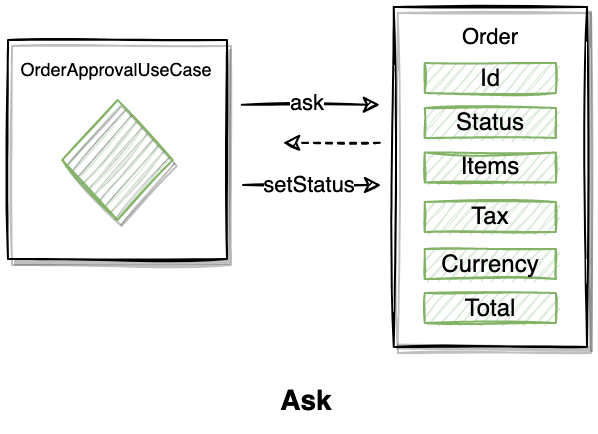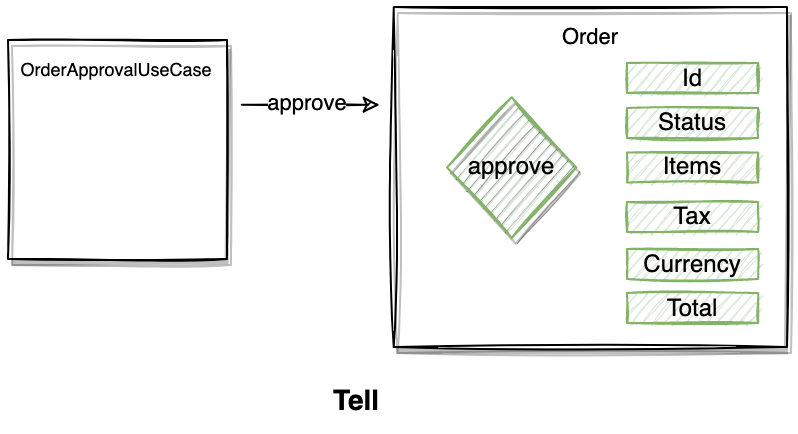Tell Don't Ask
Object Oriented Programming Paradigm is all about bundling data and operations on that data together.
In other words this principle is stating that we should Tell an object what to do rather than asking an object for its data and acting on it based on that data.

This principle is also called Feature envy.
Why?
Procedural code gets information then makes decisions. Object-oriented code tells objects to do things. that is the whole idea behind this principle.
If we do not do that we are exposing our code to different kind of issues:
- Code duplication: certain business logic may be duplicated without noticing it (state transition)
- Bad encapsulation:
- data could be exposed outside from the object itself and show too much from its internal state
- object states could be updated from the outside resulting to a wrong state object
Problems
- How to identify encapsulation issues?
- How may I preserve correctness of the internal state of my objects?
- How may I ensure to not duplicate some business logics?
How to
When a class gets data from another class in order to do some calculation or comparison on that data it means that the client class envies the other class.
Ask code

There are plenty of issues with the code below:
Orderis just a container of data- The checking state logic may be duplicated in other
Use Cases - The
business invariantsare inside theUseCaseclass, what is the purpose of theOrder?- Anything can create an
Orderinstance in a wrong state because there is no encapsulation - In
DDD, we promote to expose only behaviors / methods to the outside world
- Anything can create an
public class OrderApprovalUseCase
{
private readonly IOrderRepository _orderRepository;
public OrderApprovalUseCase(IOrderRepository orderRepository)
{
_orderRepository = orderRepository;
}
public void Run(OrderApprovalRequest request)
{
var order = _orderRepository.GetById(request.OrderId);
if (order.Status == OrderStatus.Shipped)
{
throw new ShippedOrdersCannotBeChangedException();
}
if (request.Approved && order.Status == OrderStatus.Rejected)
{
throw new RejectedOrderCannotBeApprovedException();
}
if (!request.Approved && order.Status == OrderStatus.Approved)
{
throw new ApprovedOrderCannotBeRejectedException();
}
order.Status = request.Approved ? OrderStatus.Approved : OrderStatus.Rejected;
_orderRepository.Save(order);
}
}
public class Order
{
public decimal Total { get; set; }
public string Currency { get; init; }
public IList<OrderItem> Items { get; init; }
public decimal Tax { get; set; }
public OrderStatus Status { get; set; }
public int Id { get; init; }
}
Tell code

Let's refactor this code by moving transition state inside the Order entity and enforce encapsulation.
public class OrderApprovalUseCase
{
private readonly IOrderRepository _orderRepository;
public OrderApprovalUseCase(IOrderRepository orderRepository) => _orderRepository = orderRepository;
public void Run(OrderApprovalRequest request)
=> _orderRepository.Save
(
ApproveOrReject(
request,
_orderRepository.GetById(request.OrderId)
)
);
// Should be split in 2 Use Cases
private static Order ApproveOrReject(OrderApprovalRequest request, Order order)
=> request.Approved
? order.Approve()
: order.Reject();
}
public class Order
{
public decimal Total { get; private set; }
public string Currency { get; private set; }
public IList<OrderItem> Items { get; private set; }
public decimal Tax { get; private set; }
public OrderStatus Status { get; private set; }
public int Id { get; private set; }
private Order ApproveOrReject(OrderStatus newStatus, Action checkState)
{
if (Status == Shipped)
throw new ShippedOrdersCannotBeChangedException();
checkState();
Status = newStatus;
return this;
}
public Order Approve() =>
ApproveOrReject(
Approved,
() =>
{
if (Status == Rejected)
throw new RejectedOrderCannotBeApprovedException();
});
public Order Reject()
=> ApproveOrReject(
Rejected,
() =>
{
if (Status == Approved)
throw new ApprovedOrderCannotBeRejectedException();
});
}
Constraint
- Identify decisions taken outside from an object based on its data
- Refactor this code to encapsulate this decision taking inside that given object